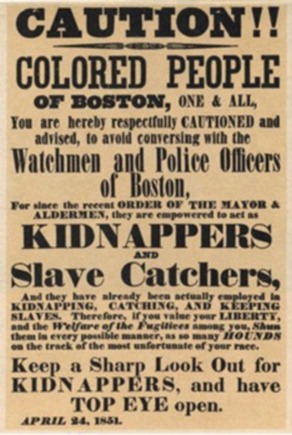User:Gulmic28
From 1850s
Contents |
[edit] The Fugitive Slave Laws
The Fugitive Slave Law of 1850 was the catalyst for Harriet Beecher Stowe writing Uncle Tom’s Cabin. Since there was already an active Fugitive Slave Law that passed in 1793, what was it about the 1850 Law that generated so much angst among the abolitionists?
[edit] The Fugitive Slave Law of 1793
Prior to the Fugitive Slave Law of 1793, southern states wholeheartedly expected the northern states to return runaway slaves based on upholding the Constitution.
“No person held to service or labor in one State, under the laws thereof, escaping into another, shall, in consequence of any law or regulation therein, be discharged from such service or labor; but shall be delivered up on claim of the party, to whom such service or labor may be due”. (U.S., Constitution, Art. 4, Sec. 2, clause 3.)
They also didn’t believe that the northerners would want this type of person in their midst. A Virginia legislative committee stated,
“For it was to be expected that the enlightened and sagacious people of the North would see at a glance, that the violation of that compact would create, and continually recruit on their soil, a class of paupers like the Parias of Hindostan; of outcasts from society; of men who are neither slaves nor citizens; a wen on the body politic; an anomaly on their institutions, and a pestilent curse to them and their posterity.” (Acts of the General Assembly of Virginia, 1849-1850, p. 245).
This original law was a result of a free black man in Pennsylvania being captured by three white men and taken to Virginia. The men were charged with kidnapping and the Pennsylvania Governor requested that they be extradited back to Pennsylvania. The Virginia Governor refused since there was no law that required the return of fugitives from justice. In addition, the law addressed the return of fugitive slaves.
The northern states responded immediately to this legislation by passing their own Personal Liberty Laws in hopes thwarting the effects of the Act as it related to runaway slaves. Some of these included anti-kidnapping laws (PA and OH); providing jury trial for fugitive slaves and providing them with an attorney (IN, CT, NY, VT); forbidding judges and justices of the peace to take these cases (CT). MA and RI also passed similar laws.
[edit] The Fugitive Slave Law of 1850
The South originally pushed to get the Act amended in 1818 but it wasn’t until 1850 that they were successful.
The South felt that due to the implementation of the North’s Personal Liberty Laws, the 1793 Law was no longer adequate; a stricter and enforceable law was needed. The Fugitive Slave Law of 1850 was just the one of eight bills passed by the Legislature that collectively became known as the Compromise of 1850.
Slaveholders now had the help of U.S. marshals in capturing runaway slaves. The Law put the responsibility on “all good citizens” to aid in the return of runaway slaves. If you refused or if you helped in the aid of a runaway slave, you could be fined $1,000 and/or imprisoned for 6 months.
A master just had to claim a black person as their slave – there was no jury trial for the black person nor could they testify on their own behalf. This resulted in free blacks, including former slaves who had bought their freedom, and generations of black people that had been born free and had never known the bonds of slavery, to be kidnapped, claimed, and returned as slaves.
The process of hearing cases changed from a judicial one to an administrative one where federal commissioners instead of judges heard the cases. This drastically quickened the process from weeks down to just a few hours. Commissioners received a fee of $10 for every fugitive returned to slavery and only $5 if they found that the accused should be free. Marshals also received a fee for every fugitive they brought in.
[edit] 1851 Boston Poster
[edit] 1850 U.S. and Slave Population
In 1850, the U.S. population was 23.2 million; of this 19.5 million (84%) were white; 3.2 million (14%) slaves; and .5 million (2%) free-colored. More than half (56%) of slaves were under the age of 20. 75% were under the age of 30!
[edit] Table: 1850 Age of Slaves
[edit] Bibliography
- Campbell, Stanley W., The Slave Catchers: Enforcement of the Fugitive Slave Law 1850-1860, The University of North Carolina Press, Chapel Hill, North Carolina, 1970.
- Holt, Michael F., The Fate of Their Country: Politicians, Slavery Extension, and The Coming of the Civil War, Hill and Wang, New York, 2004 (p.86-87).
- Klein, Herbert S., The Atlantic Slave Trade, Cambridge University Press, Cambridge, United Kingdom, 1999 (p.171).
- Reynolds, Moira D., Uncle Tom’s Cabin and Mid-Nineteenth Century Unites States, McFarland & Company, Inc., Jefferson, North Carolina, 1985 (p. 5).
- The 1850 U.S. Census http://www2.census.gov/prod2/decennial/documents/1850a-01.pdf
- The Fugitive Slave Act of 1850 http://www.nationalcenter.org/FugitiveSlaveAct.html
- The Fugitive Slave Act of 1793 http://www.ushistory.org/presidentshouse/history/slaveact1793.htm
Recommended Reading
- Berlin, Ira, et al. (eds.), Remembering Slavery, The New Press, New York, 1998.
- Yetman, Norman R., ed., Voices from Slavery: 100 Authentic Slave Narratives, Dover Publications, Inc., Mineola, New York, 2000.
- Slave Narratives, Literary Classics of the United States, New York, 2000.


